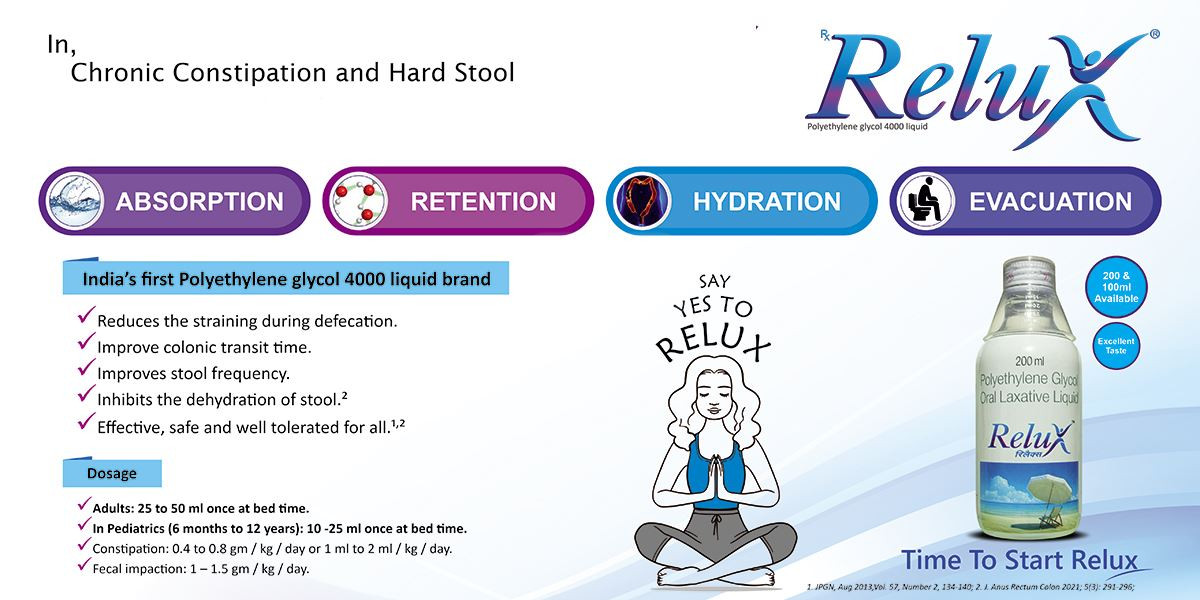Benefits of PEG 4000 Sugar free Laxative
WHAT IS POLYETHYLENE GLYCOL
Polyethylene Glycol (PEG) are polymers of Ethylene Oxide. PEG is a biocompatible, synthetic, hydrophilic polyether compound that has many applications. They usually have a molecular weight of between 300 to 20,000 Daltons. PEG has varied uses from industrial manufacturing to manufacture of medicine. With varying molecular weight, PEG can have slight effects on its characteristics, mostly on its shape and physical appearance but majorly it is non-toxic, colourless, inert, odourless, and non-volatile. Also, it is highly soluble in water, and organic solvents such as benzene, carbon tetrachloride, and chloroform.
USE OF POLYETHYLENE GLYCOL
- One of the major use of PEG in the Medicinal Industry is as a Laxative. PEG is used as an osmotic agent that increases water content in the faeces and thus helps in easing and treating constipation both in adults as well as children.
- PEG has seen widespread use in the biomedical & pharmaceutical industry due to its non-toxicity and high solubility.
- Other than as a laxative, PEG is also used for whole bowel irrigation in preparation of GI tract investigation or surgery. PEG has also extended its use in medical creams, ointments and medical solvents.
MECHANISM OF ACTION OF POLYETHYLENE GLYCOL
PEG is an Osmotic Laxative. Osmotic Laxatives are usually substances that are very poorly absorbable and draw water into the lumen of the bowel. PEG causes increased water retention in the colonic lumen by bringing in water molecules. This in turn produces loose stool and relieves constipation.

TYPES OF LAXATIVES
Broadly there are four (4) types of laxatives which are used in the pharmaceutical industry. They are
Bulk forming Laxatives
-
- They are also known as fibre supplements. They act in the same lines as dietary fibre works in the body. They increase the bulk of the stool by retaining water in turn making the bowel push out the stool more effectively. They are usually recommended in adults as a first line initial laxative. Bulk forming laxatives takes 12-24 hours to start working.
- Examples are Psyllium Husk & Methyl cellulose
Osmotic Laxatives
-
- Osmotic laxatives act by increasing the amount of water secreted in the bowel. It makes the stool softer and easier to pass. Usually takes 2-3 days to start working.
- Examples are Lactulose, Macrogol & Polyethylene Glycol.
Stimulant Laxatives
-
- Stimulant laxatives essentially stimulate the gut wall in turn speeding up bowel movement. This helps in pushing out bowel clearance at a faster pace. It normally takes 6-12 hours to work.
- Examples are Bisacodyl, Senna & Sodium Picosulfate
Stool Softener Laxatives
-
- Stool softeners reduce the surface tension within the stool. This helps in more water absorption in the stool and thus softening it. They take 12-72 hours to work.
- Examples are Arachis oil & Docusate
Other than these broad categorization, some of the less commonly known and used types of laxatives are:
-
- Lubricant Laxatives: These lubricate the intestines by decreasing the amount of water absorbed by the intestines
- Saline Laxatives: These are used when there is no blockage in the bowels. Often, they are enemas used to empty the bowel before invasive procedures or surgery
- Prokinetic Laxatives: These are used for severe constipation in conditions such as Irritable Bowel Syndrome (IBS) and Chronic Idiopathic Constipation.

POLYETHYLENE GLYCOL (PEG) 4000
PEG 4000 is an advanced version of PEG 3350 + Electrolytes. PEG 4000 is an osmotic laxative just like PEG 3350 but without the electrolytes. There have been numerous studies and trials to differentiate the advantages and disadvantages between these two slightly different forms of laxatives. Some of the major benefits of PEG 4000 are as follows:
PEG 3350+Electrolytes:
- PEG 4000 results in a higher number of stools per week which results in better easing constipation
- Helps in reducing the condition of painful stools in a lesser number of days which helps the patient getting relieved from the painful conditions
- There is a marked decrease in the requirement in the use of stimulant laxative to further aid in relieving constipation.
- Further there has been seen that PEG 4000 is far less difficult in administration. This is aided by the fact that PEG 4000 has a much more palatable taste.
- Use of rescue medication is lesser in requirement with the use of PEG 4000
Lactulose:
- Abdominal cramping and bloating is not seen with the use of PEG 4000
- With a higher colonic transit time, the onset of action is quicker with PEG 4000 and thus helps in relieving the symptoms faster.
- Studies have shown a much higher incidence of stool passing with PEG 4000 along with a marked reduction in anal irritation.
- There is a higher rate of stool frequency along with quicker reduction in abdominal reduction with the use of PEG 4000
- Studies have shown superior efficacy with the use of PEG 4000 compared to Lactulose
Other salient features with the treatment of PEG 4000 are:
- Paediatric patients have also been successfully treated with PEG 4000 and have been able to resume normal bowel functions at the end of the treatment period.
- Long term use of PEG 4000 has shown it to be effective and well tolerated with no new side effects noticed both in paediatric and adult population.
- PEG 4000 is an osmotic laxative without electrolytes. Various studies have proven beyond doubt that the absence of electrolytes is safe and effective and in not inferior to products with added electrolytes.
- It has also been seen that a 3 month treatment period with PEG 4000 has restored normal bowel functions in majority of the patients.
- PEG 4000 has been proposed to be the first line therapy in children with functional constipation given its safety profile and efficacy.
- PEG 4000 being an inert molecule, it has no effect on the Gastro-Intestinal Flora and thus doesn’t cause Gastro-Intestinal dysfunction or infection.
